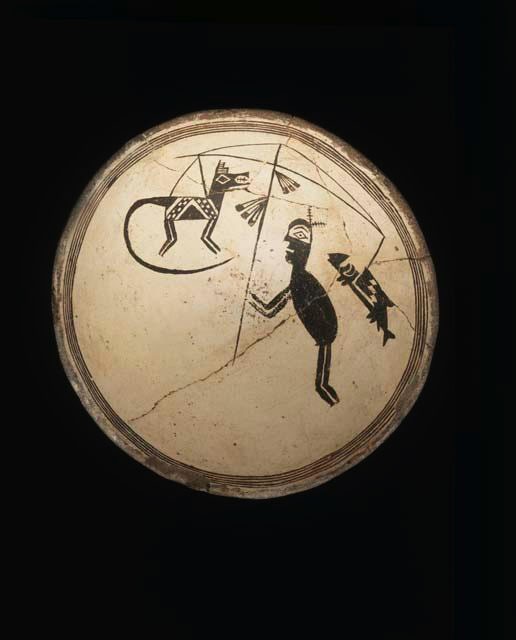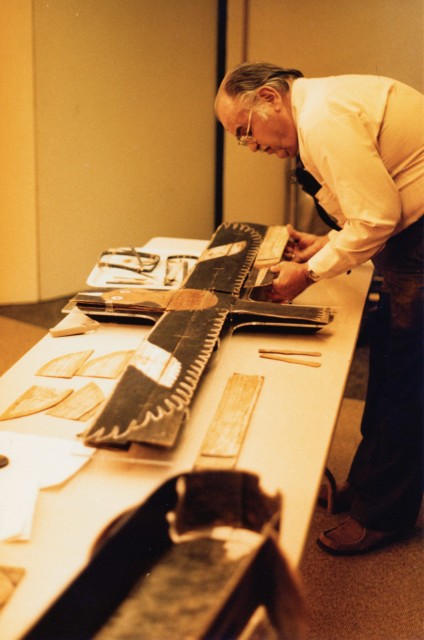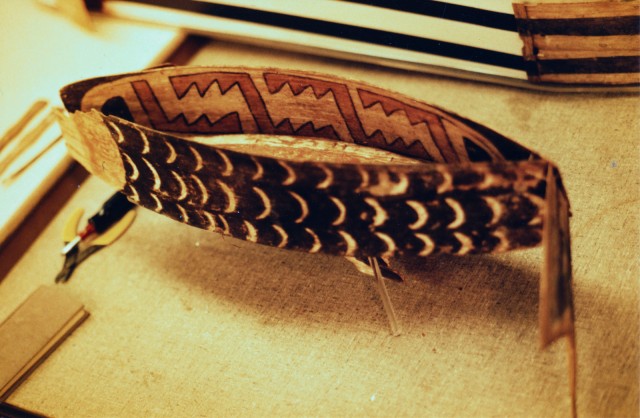- Home
- >
- Preservation Archaeology Blog
- >
- Using a Multidisciplinary Approach to Interpret Ar...
Lindsay Shepard, Arizona State University
As an archaeology student, a question I’m frequently asked is, “How do you know that (insert artifact name here) was really used in that way?” Because the objects I study are not accompanied by textual evidence, some of my non-archaeologist friends are skeptical as to whether or not we can truly determine how certain artifacts were used. And honestly, thought a stone saw’s use is obvious, some artifacts are pretty ambiguous. Take, for example, the object depicted on the Mimbres bowl pictured below.

The object in this scene, which appears on several Mimbres bowls, appears to be some type of mobile, but what else could it be? Did it have a ritual function, or was it possibly used as some form of entertainment? Was it a contraption used to process animals after the hunt? Although some artifacts, or depictions of artifacts such as this one, can be difficult to interpret, looking at comparable artifacts found in other contexts and incorporating a multidisciplinary approach can be helpful.
Composite wooden artifacts found in caves throughout the U.S. Southwest may offer insight as to what the mobile-like objects depicted on Mimbres pottery were and in what context they may have been used. An example of these wooden artifacts (pictured below) consists of items recovered from a cave located in either the Upper Gila Region or the Mogollon Highlands, not far from where our field school is currently working.


Objects like these bear a striking resemblance to components of the mobiles depicted on Mimbres bowls. The second picture, for example, looks a lot like the fish shown on the bowl pictured above. If one assumes the composite wooden artifacts to indeed be the same type of artifact pictured on the bowls, the context these items are found in can help in interpreting the function of the mobiles. In both ancient and modern times, many cultures in the U.S. Southwest have or currently do consider caves to be sacred places, serving as portals to the underworld and the deities and spirits that reside there. The fact that the wooden items were recovered from caves may indicate that mobiles served a ritual role, rather than a purely functional one.
Another method that can be used to interpret artifacts is to observe how similar objects are used by modern cultures and then use that information to infer how the artifact may have been used in the past. Although ethnographic analogies don’t provide actual proof as to how the comparable artifact was used in the past, these comparisons help generate ideas about the artifact’s potential function. For example, according to anthropologist Trudy Griffin-Pierce in her book Earth is my Mother, Sky is my Father, some peoples in the Western Pueblo region use mobile-like apparatuses while conducting ritual dramas. The standard is another similar-looking object, and is used by some modern cultural groups to indicate sodalities. Anthropologist Elsie Clews Parsons, who studied Native American cultural groups in the U.S. Southwest, witnessed the carrying of standards during ritual processions and their subsequent placement outside of kivas during the remainder of the ceremony. These ethnographic examples further reinforce the idea that the mobile-like objects pictured in Mimbres pottery may have been used in ritual contexts.
Even though it may be difficult at times to determine exactly what a specific artifact or depicted object was used for, the analysis of similar artifacts recovered from different contexts combined with ethnographic analogies can be helpful in interpreting what type of context an ambiguous artifact may have been used in and what type of function it potentially had.
I would like to thank Stephanie Gilmore and Stephen Lekson with the University of Colorado Museum of Natural History, and Jeff Creighton with the Northwest Museum of Arts and Culture for their permission to use the photographs included in this blog post. Also, a special thank you to Will Russell for his assistance in gaining these permissions and for his general helpfulness.
One thought on “Using a Multidisciplinary Approach to Interpret Artifacts”
Comments are closed.
Explore the News
-
Join Today
Keep up with the latest discoveries in southwestern archaeology. Join today, and receive Archaeology Southwest Magazine, among other member benefits.
In talking with the Acoma in northern New Mexico who often have two clan associations, one from their mother and one from their father, I wonder if these are clan totems. Just a thought!